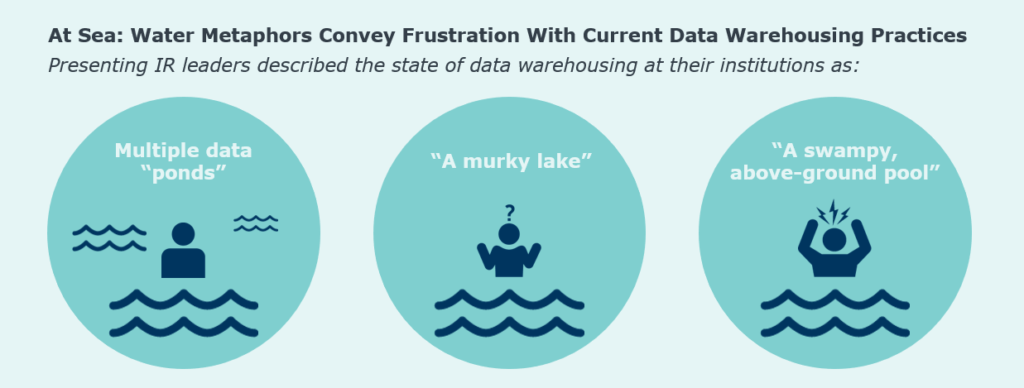This year, EAB was a proud sponsor and attendee at the Indiana Association of Institutional Research (INAIR) Annual Conference. Along with the rest of our Education Data Hub team, I was grateful to spend time getting to know the community that gathered at Indiana University-Purdue University Indianapolis for three days of learning and sharing ideas around data and reporting in higher education.
Across the sessions I attended, here are three things I learned about the state of play in Institutional Research (IR) today:
1. The nature of campus data needs is changing—and IR’s job is too
82%
Attendees were relentless in their recognition of a growing need for more mature and strategic analyses to come from the Institutional Research office. In fact, the emergence of “Institutional Effectiveness” (the cabinet-level evolution of the compliance- and partnership-driven Institutional Research) was the topic of multiple sessions. Between 1995 and 2015, the number of VPs of Institutional Effectiveness has risen from 43 to over 500.
IPEDS, state reporting, and accreditation needs have not diminished—but at the cabinet level, leaders stepping into these roles must augment their office’s compliance work by supporting complex student success, operational efficiency, and diversity and equity initiatives. Supporting these mission-critical efforts is a high priority for institutional researchers, but there is a significant gap to bridge between the two.
2. The state of data warehousing in higher education is undermining IR’s progress
“Water, water, everywhere, / Nor any drop to drink”—such is the famous cry of the Ancient Mariner in Coleridge’s Rime, and such is the echoing sentiment of IR leaders today. Despite various ongoing efforts toward data warehousing, campus leaders from one panel described their work to date in a series of escalating water-focused metaphors.

For each campus, the effort to aggregate data for analysis was well underway, but the impact of siloes and poor data quality and integrity measures continued to trap IR professionals in the disheartening and time-intensive work of data filtration.
3. Centralized data governance is top-of-mind for leaders looking to accelerate progress
IR leaders are taking on a more strategic role as the appetite for data grows. To save their teams some of the time and effort it currently requires to analyze campus data, many IR leaders are urgently pushing to improve data governance. Aggregating data into warehouses is not good enough, not least because the data contained there represents multiple one-dimensional views of campus work and processes, each with its own definitional quirks and inconsistencies.
To make the most of campus data, INAIR attendees were pushing for a greater focus on augmenting data warehousing work with an intentional, cross-silo focus on data governance. IR can lead the charge, but stakeholders from every unit must be at the table to help drive data standardization and quality improvement.
As Institutional Research and Institutional Effectiveness leaders continue to drive towards strategic analytics in higher education, the intersection of data integration and data governance that powers them should continue to be the highest priority. Only when campuses develop a single, comprehensive view into mission-critical data will they be able to support these differentiated efforts sustainably. Until then, the themes of INAIR will continue to ring true: despite a widespread desire to move onward and upward, institutional researchers will be trapped in an endless spiral of data sourcing and manipulation.
You may also like
Get data governance decisions right
This video outlines how to create a quick and efficient data governance decision process.
Preparing for a new approach to data governance
Establishing and sustaining effective data governance means bringing campus on board with the need for data reform. Before jumping into a data governance redesign effort and creating a framework for oversight, CIOs and other campus sponsors should prepare campus for the upcoming change by identifying areas for improvement, enfranchising leaders, and communicating the need for investment in data governance.


